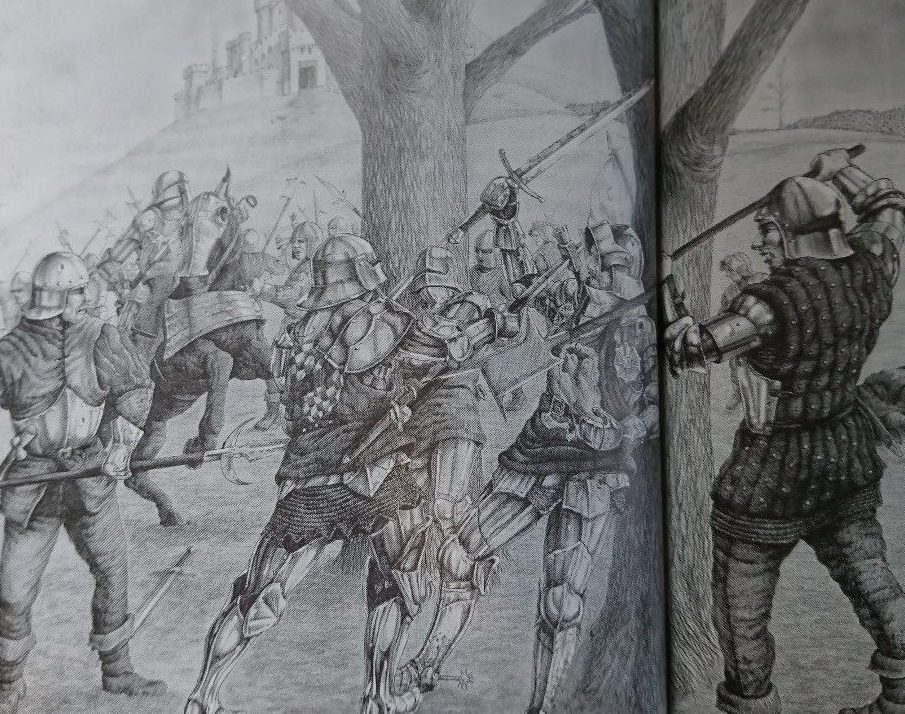
This week Josh Flint from the Local and Family History Department will be using the new Research Guide on Yorkshire Battles to examine the fascinating Battle of Wakefield in 1460 which saw the death of Richard, Duke of York and has been argued to have changed the course of English History while also highlighting the exceptional items that the Leeds Central Library has on the battle.
The Battle of Wakefield is one of the most intriguing battles of the Wars of the Roses and involves treachery, deceit and ferocious fighting. This battle was fought between the Lancastrians and Yorkists just outside of Sandal Castle in Wakefield on the 30th December 1460. Richard, Duke of York and his Yorkist army was stationed within Sandal Castle for Christmas when they were surrounded by a much larger Lancastrian army, under the leadership of Henry, Duke of Somerset. The Duke of York then left Sandal Castle and him and his army were routed by the much larger Lancastrian force. Due to poor primary source evidence from the Wars of the Roses period it is unknown why York left the relative safety of Sandal Castle to fight the much larger Lancastrian army. York could have been worried about being starved out of the castle due to a prolonged Lancastrian siege or as one theory states York could have been tricked by Lancastrians dressed as Yorkists and York may have left the castle to welcome the new reinforcements. The decision to leave the safety of the castle may not be known but the outcome of the battle is in no doubt as the Lancastrians viciously routed the much smaller Yorkist force resulting with Richard, Duke of York being killed.
The result of the battle changed the course of British History as it cemented the divisions between the Yorkists and Lancastrians and rallied the remaining Yorkists under the new leadership of Richard, Duke of York’s son the eighteen year old Edward, Earl of March – future Edward IV – and the powerful Richard, Earl of Warwick, later known as the Kingmaker. The Battle of Wakefield made Edward and Warwick more determined to not only defeat the Lancastrians but also to take the crown of England from Henry VI.

And surely my mind is, rather to die with honour nor, then to live with shame for of honour commeth fame, and dishonour riseth infamy. Their great numbre shall not appall my spirites, but to incourage them.
The Leeds Central Library Collections has a wide variety of books that describe the Battle of Wakefield including the Edward Hall Chronicle, The Union of the Two Noble Families of Lancaster and York from 1550. Hall’s Chronicle describes the History of England ending with the reign of Henry VIII. Hall details how Richard, Duke of York knew that he was outnumbered but decided to fight the Lancastrians to keep his honour and thought that his own military excellence could hold off the Lancastrians while he waited for reinforcements. Hall recounts how Richard, Duke of York was encircled on all sides and even though his Yorkist soldiers fought manfully were overwhelmed and slain. Hall describes in great detail how the Yorkists were mercilessly killed during the Battle of Wakefield and the effects that this had on the Yorkist force. Hall writing in Tudor times has a talent for elaborating information when the original primary sources of the Wars of the Roses offer scarce detail, however his overall theme about the viciousness of the time cannot be understated.

Duke of York
See, ruthless queen, a hapless father’s tears:
This cloth thou dip’dst in blood of my sweet boy,
And I with tears do wash the blood away.
Keep thou the napkin, and go boast of this:
And if thou tell’st the heavy story right,
Upon my soul, the hearers will shed tears;
Yea even my foes will shed fast-falling tears,
And say ‘Alas, it was a piteous deed!’
William Shakespeare’s Comedies, Histories and Tragedies 1623 gives a dramatic account of Richard, Duke of York’s last stand. In Henry VI Part 3 Shakespeare describes how Richard, Duke of York’s forces lost the battle after being completely overwhelmed and in a complete work of fiction how Henry VI’s wife, Queen Margaret of Anjou, made York clean his face with a handkerchief covered in his twelve year old son’s blood. Even though this is a fictional event the brutality and the ruthlessness with which Shakespeare portrays the Lancastrians is accurate to how vicious this and many battles of the Wars of the Roses were.

Leeds Central Library has many exciting books which detail the events of the Battle of Wakefield, my personal favourite is Alfred Stanfield’s photographic book, Sandal Castle and the Battle of Wakefield, written in 1891. This fascinating book chronicles the events of the battle in great detail stating that he believes that Richard, Duke of York was tricked into exiting Sandal Castle by a Lancastrian ruse where they dressed up as Yorkist reinforcements. Interestingly Stanfield also includes photographs that he personally took of Sandal Castle on a family trip to Wakefield in the late 1880’s. These photographs offer a strange experience of seeing Stanfield’s children playing in the same place where Stanfield is describing a brutal battle. I find this book very enlightening as it brings the 15th Century Battle of Wakefield, 19th Century Photography and the modern 21st Century reader together seamlessly.
References
Haigh, P. A. Wakefield & Towton – The Wars of the Roses (London 2001) Classmark: Y 942.04 HAI
Stanfield, A. W. Sandal Castle and the Battle of Wakefield (Wakefield, 1891) Classmark: YQ WAK 942
2 Comments Add yours